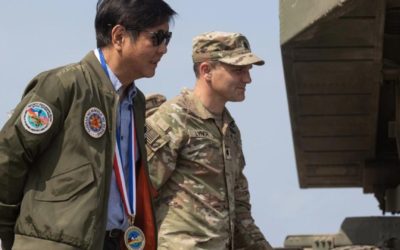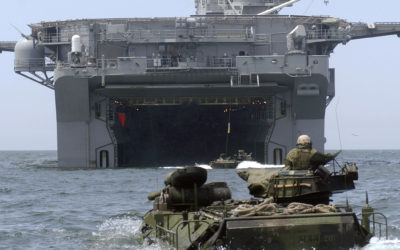On April 26, U.S. President Joe Biden welcomed South Korean President Yoon Suk-yeol to the White House for a summit meeting to celebrate the seventieth anniversary of the U.S.-South Korea alliance and open a new chapter for the next seventy years of expanded cooperation. Amid a substantial list of topics discussed by the two leaders, extended deterrence emerged as the top deliverable.
The Maritime Security Roles of Coast Guards in Southeast Asia
The Maritime Security Roles of Coast Guards in Southeast Asia
The Maritime Security Roles of Coast Guards in Southeast Asia
Coast Guards’ Interests in Maritime Security
In several Southeast Asian states, coast guards have become the primary agencies tasked with maintaining maritime security against non-military threats at sea. This is a task of no small measure as the majority of regional countries are dependent on the sea lines of communications to support their emerging economies.
Coast guard organizations’ interests can be divided into four areas. The first is maritime safety, which includes navigational safety, search and rescue, vessel safety inspection, and other related operations that ensure the safety of life and property at sea. The second is marine environmental protection. Coast guards ensure that the sea is protected against the threats of pollution—whether chemical or oil—prohibits illegal fishing, and prevent environmental degradation. These activities ensure the sustainability of the sea. This is also an interest for the coast guard since fisheries and other aquatic resources contribute to the region’s economy.
Third is maritime law enforcement, which has as its ultimate goal the establishment and maintenance of a rules-based maritime order. However, maritime law enforcement is a wide-ranging, diverse role that cannot be homogeneously defined. Responsibilities are outlined mainly by the states’ domestic laws or by the international conventions ratified. Finally, coast guards relieve navies of their constabulary roles, so that navies can focus on territorial defense and so states’ resources can be allocated more efficiently. While regional navies are generally capable of these roles, it would be uneconomical and irrational for expensive naval warships to invest their efforts in activities such as search and rescue operations or apprehending illegal fishermen.
Coast Guards’ Perceptions of the Most Significant Threats
From Southeast Asian coast guards’ perspective, the most significant maritime security risks are the increasing non-traditional security threats and the utilization of grey-zone strategies by some state actors. In its daily operations, a coast guard is persistently dealing with non-state actors that are engaged in illegal fishing, piracy, human smuggling, drug trafficking, kidnapping, and armed robbery at sea, among other activities. These can cause loss of lives or damage to property and could also harm the environment and hamper economic growth.
Regarding grey-zone strategies, coast guards are particularly preoccupied with addressing this concern in the disputed waters in the South China Sea. It is notable because any miscalculation in response to grey-zone strategies could lead to a more significant armed conflict.
Coast Guards’ contribution to Maritime Security
Coast guards contribute to maritime security in six different facets. First, the coast guard’s maritime safety role supports the safe passage of ships and cargo in Southeast Asian waters. Through this function, it supports the economic growth of not just the state to which the coast guard belongs, but also contributes to regional development.
Second, the coast guard’s role in protecting the marine environment ensures sustainable development and safeguards biodiversity. The coast guard’s presence at sea enables the state to arrest and detain vessels that are damaging the marine environment.
Third, coast guards enforce both domestic and international maritime law to maintain a maritime order. The fourth significant contribution is to allow the navy to focus on territorial defense by carrying out the constabulary roles. The coast guard can also be used as a diplomatic instrument engaging other regional countries and developing cooperation to meet shared goals regarding safe, protected, secure and peaceful seas. Lastly, the coast guard can deescalate tensions among other states with overlapping claims in disputed waters.
Coast Guard operations in the Maritime Security Environment
Since coast guards’ roles support the mutual interests of regional countries, these organizations protect and advance their interests by expanding their multilateral cooperation. These multilateral engagements encapsulate each function of the coast guard. For example, engagements may focus purely on maritime search and rescue or the prevention of maritime pollution. Coast guards’ international engagement serves the interest of each state and amplifies its relevance to economic development and national security. Through these cooperative initiatives, coast guards can create a common understanding of how to respond to various threats that could jeopardize the maritime industry. These connections could also prevent provocation and deescalate tension.
Evolution of Coast Guards’ Maritime Security Roles
Regional coast guard organizations evolved tremendously over the last twenty years. After gaining independence, the Philippines, Malaysia, Indonesia, and Vietnam created their respective navies as part of their military establishments. However, with their intent of strengthening their maritime governance – particularly in improving maritime safety, marine environmental protection and maritime law enforcement – these countries also later created coast guards.
As their respective coast guard organizations evolved, the navies started to relinquish their constabulary roles. While coast guard expansion can simply be illustrated by the increase in budgetary allocation, upsurge in troop ceiling, and acquisition of flotilla and air assets, its evolution can best be expounded by its emerging significance as another maritime force separate from that of the Navy. Such inclination can be seen from the Philippine Coast Guard, Malaysia Maritime Enforcement Agency, BAKAMLA (Indonesia’s de facto nascent Coast Guard), and the Vietnam Coast Guard.
In the last twenty years, coast guards’ functions have shifted from being mere lighthouse keepers and oil spill cleaners to being essential patrollers of disputed waters in the South China Sea.
While the navy had been the primary option for deployment in contested waters, the coast guard has now taken over such a critical role. The 2012 Scarborough Shoal standoff between the Philippine Navy and Chinese government ships was a turning point that raised awareness among the claimant states that utilizing warships for maritime law enforcement in contested waters could be interpreted as militarizing the dispute. While Chinese efforts to blame the Philippines were propaganda, the effectiveness of the Chinese communication made the Southeast Asian claimant states recognise the value of utilizing white ships to patrol contested waters. However, it must be emphasized that such strategic alteration does not mean that the coast guard is assuming navies’ responsibilities; instead, it shows that using the coast guard has become a calibrated tactic so as not to provoke other countries and to deescalate tensions.
Coast guards are incorporated into grey-zone strategies in two ways. First, coast guards are seen as part of the grey-zone tactic to occupy disputed waters without being criticized for militarisation. Over the years, some coast guard organizations in the East Asian region have constant and increasing presence. Accordingly, these white ships are being used to ascertain the administrative control of the state over the disputed waters and at the same time protect their fishermen from harassment from other claimant states.
Secondly, coast guard organizations have become the only safest solution to counter the grey-zone strategy of other states to prevent a possible armed conflict. Learning from the Scarborough Shoal incident, Southeast Asian countries have utilized white ships to counter illegal fishing and to chase off unauthorized foreign flag research vessels. The fear of being criticized that the dispute is being militarized compels the states to rely on the white ships without calling the navy.
Additional Context
Coast guards are universally uniformed professions. Most often, the ranks of the coast guard personnel follow the ranks of the naval service. This is because most of the coast guard organizations in the world used to be part of the navy and were eventually separated, or remain sub-units of the Navy. Some, like the US and Indian Coast Guards, are part of the military, while others, like the Japan Coast Guard, have distinct civilian traditions. Likewise, it is noticeable that Southeast Asia’s contemporary coast guards (like those in East Asia) are often separate agencies from the Navy and do not have a military character. These coast guard organizations in the region are also not part of the civilian police force except only the Singapore Police and Coast Guard. Nevertheless, all of Southeast Asia’s coast guard organizations will be part of the military in war times.
In comparison to navies, coast guards are more humanitarian and support the domestic necessities of the state. It does not require powerful naval armaments to carry out its mission of enforcing laws against the criminal elements at sea. More importantly, it does not need to go to war or find foreign invaders to fulfill its day-to-day mission.
However, despite its numerous roles, the coast guard cannot fulfill the Navy’s role at sea. It is still important to emphasize that the Navy’s role in defending the sovereignty against state actors is a job that the coast guard cannot perform. Further, the extensive naval warfare training and the warships’ capability to carry out territorial defense are something that the coast guard organizations do not have. Another distinct physical difference between the two is the color of their ships; for the Navy, its color is grey and often called warships or grey hulls, but in the case of the coast guard, its vessels are painted white which is why it is also dubbed as white hulls.
Interestingly, the maritime constabulary roles that were earlier mentioned gave enough reasons for the states to create another maritime agency separate from the Navy. These roles do not just support the maritime stakeholders for their safety but also support the government’s economy to collect tax duties and safeguard the sea trade routes. Public pressure and economic necessity are compelling reasons why countries started building a coast guard agency. Historically, these were the foremost raison d’être why the first coast guard, the United States Revenue Cutter Service, was created more than two centuries ago and they remain driving forces behind today’s Southeast Asian coast guards.
Republished with permission from the author.

Commodore Jay Tristan Tarriela is a one-star flag officer in the Philippine Coast Guard.
Related Articles
President Marcos Jr. Meets With President Biden—But the U.S. Position in Southeast Asia is Increasingly Shaky
Over a four-day visit to Washington, Philippine President Ferdinand Marcos Jr. has been welcomed to the White House and generally feted across Washington. With President Biden, Marcos Jr. (whose father was forced out of office in part through U.S. pressure, and whose family has little love for the United States) affirmed that the two countries are facing new challenges, and Biden said that “I couldn’t think of a better partner to have than [Marcos Jr.].”
The U.S. is about to blow up a fake warship in the South China Sea—but naval rivalry with Beijing is very real and growing
As part of a joint military exercise with the Philippines, the U.S. Navy is slated to sink a mock warship on April 26, 2023, in the South China Sea.
The live-fire drill is not a response to increased tensions with China over Taiwan, both the U.S. and the Philippines have stressed. But, either way, Beijing isn’t happy – responding by holding its own staged military event involving actual warships and fighter jets deployed around Taiwan, a self-governed island that Beijing claims as its own.



